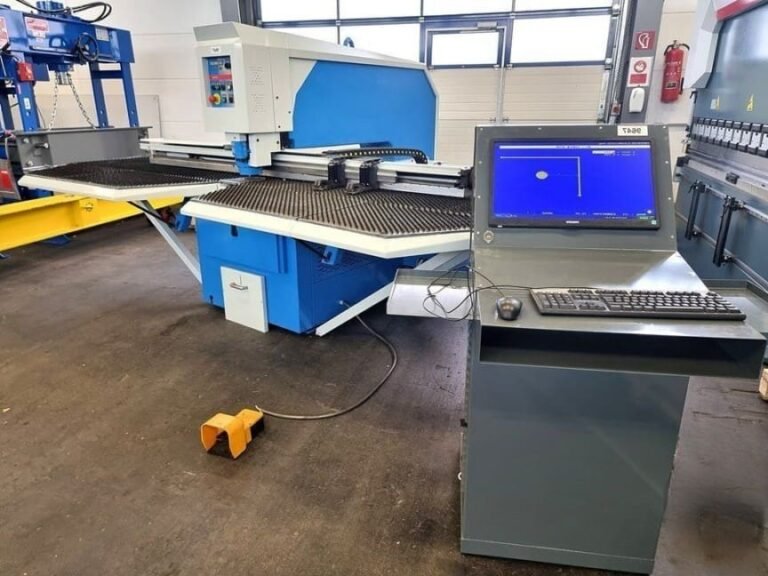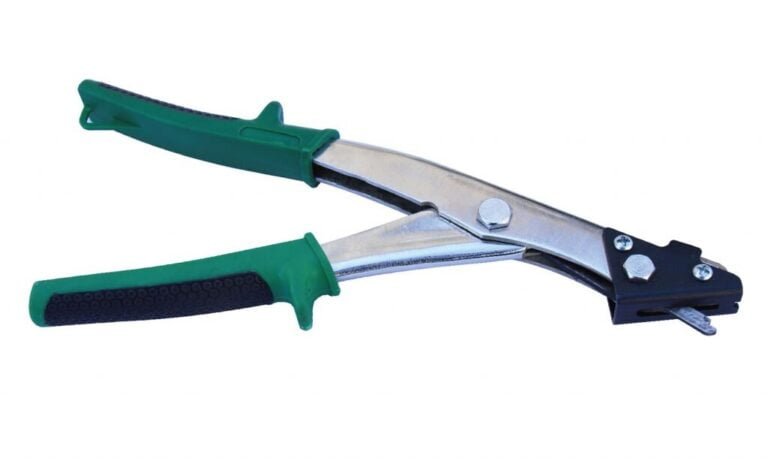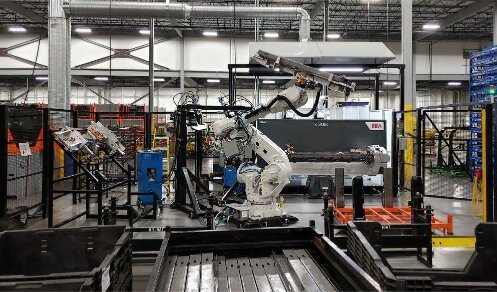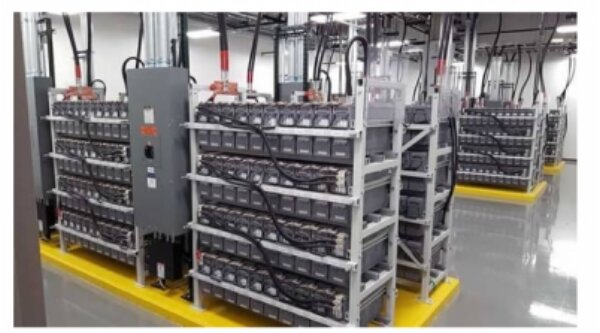Veel mensen die net beginnen met plaatbewerking worstelen met hoe ze complexe vormen kunnen snijden zonder duur gereedschap te gebruiken. Die frustratie groeit als lasersnijden overkill lijkt en ponsen geen krappe rondingen aankan. Knabbelen biedt een verrassend eenvoudige, flexibele oplossing. Het is voordelig voor prototypes, eenmalige en speciale opdrachten die de kosten van volledige matrijzen niet rechtvaardigen. Als je je beperkt voelde door de snijopties, is dit misschien de methode die je mist.
Deze methode klinkt eenvoudig, maar het vermogen om te werken met complexe vormen en krappe budgetten maakt het waardevol in veel workshops.
Wat is knabbelen in plaatmetaal?
Knabbelen is een snijproces dat gebruikt wordt bij plaatbewerking. Het maakt gebruik van een pons- en matrijzenset om kleine, herhaalde stukken materiaal te verwijderen. Dit gebeurt stap voor stap.
Het gereedschap beweegt in korte bewegingen over het werkstuk. Elke pons maakt een klein gaatje of inkeping. Deze gaatjes overlappen elkaar. Samen maken ze een snede die elk pad volgt.
Knabbelmachines kunnen manueel of CNC-gestuurd zijn. Manuele knabbelmachines zijn geschikt voor handgestuurd werk. CNC knabbelmachines maken gebruik van vooraf ingestelde paden om schonere en nauwkeurigere resultaten te verkrijgen.
Dit proces werkt op veel plaatmetalen. Staal, aluminium en roestvrij staal zijn gangbare keuzes. De metaaldikte blijft meestal binnen een werkbaar bereik - vaak minder dan 6 mm.
Het is ideaal voor krappe rondingen, interne uitsparingen en onderdelen in kleine series. Omdat er geen aangepaste matrijzen nodig zijn, bespaart het geld bij korte productieruns.
Essentiële gereedschappen en uitrusting voor knabbelen
Om knabbelen effectief te gebruiken, heb je de juiste apparatuur nodig. De machine, het gereedschap en de ondersteunende gereedschappen spelen allemaal een cruciale rol bij het bepalen van de effectiviteit van het proces. Hieronder staan de belangrijkste onderdelen die in de meeste opstellingen worden gebruikt.
Soorten knabbelmachines
Er zijn twee hoofdtypen knabbelmachines: handmatige en CNC-gestuurde.
Handmatige knabbelscharen worden vaak met de hand vastgehouden of op een werkbank gemonteerd. Ze zijn geschikt voor kleine volumes of basis vormwerk. De operator stuurt de machine met de hand, waardoor deze flexibeler maar minder precies is.
CNC nibblers zijn geautomatiseerd. Ze volgen een digitaal ontwerp om de plaat en pons in een specifiek pad te bewegen. Deze zijn beter voor nauwkeurigheid en consistentie in grotere volumes.
Sommige revolverstansmachines hebben ook ingebouwde knabbelfuncties. Dit voegt veelzijdigheid toe zonder dat er aparte apparatuur nodig is.
Knabbelmachines Onderdelen
Een knabbelmachine heeft verschillende belangrijke onderdelen:
- De pons is het bewegende deel dat op het metaal slaat. Hij duwt kleine stukjes door de matrijs, het vaste deel onder de plaat. De matrijs ondersteunt het metaal en bepaalt de vorm van de snede.
- De werktafel houdt het metaal vlak. Sommige tafels zijn verstelbaar om grote of zware platen te ondersteunen.
- De motor of het pneumatische systeem drijft de pons aan. Bij CNC-systemen leidt een controller het pad van de pons met behulp van G-code.
Extra gereedschap voor precisiewerk
Sommige extra hulpmiddelen helpen het eindresultaat te verbeteren:
- A ontbramen gereedschap verwijdert scherpe randen die door de pons zijn achtergelaten. Hierdoor blijft het onderdeel veilig te hanteren en ziet het er beter uit.
- Plaatklemmen voorkomen dat het materiaal verschuift tijdens het snijden. Dit komt de nauwkeurigheid ten goede.
- Sjablonen of hulplijnen kunnen helpen bij het handmatig knabbelen, waardoor het gemakkelijker wordt om rondingen te volgen of vormen te herhalen.

Stap-voor-stap handleiding voor knabbelen aan plaatmetaal
Plaatwerk knippen is eenvoudig als je duidelijke, stapsgewijze instructies volgt. Hier lees je hoe je je werk effectief voorbereidt, instelt, snijdt en afwerkt.
Het plaatwerk voorbereiden
Begin met het kiezen van de juiste dikte en het juiste type metaalplaat. Controleer of het metaal vlak en schoon is. Verwijder vuil, olie of roest, dat kan je snede beïnvloeden.
Gebruik vervolgens een marker of een potlood om je snijpad duidelijk af te tekenen. Zorg dat de lijnen goed zichtbaar zijn. Zet het metaal stevig vast om te voorkomen dat het wegglijdt tijdens het snijden.
De Nibbler instellen
Controleer je knabbelgereedschap zorgvuldig. Zorg ervoor dat de pons en matrijs schoon en scherp zijn. Stel ze bij indien nodig. Smeer bewegende delen lichtjes om het gereedschap soepel te laten werken.
Stel de snelheid en de slagdiepte van je machine in op basis van de metaaldikte en de vorm die je gaat snijden. Pas de geleiders of omheiningen aan zodat je de gemarkeerde lijnen nauwkeurig kunt volgen.
De snede uitvoeren
Houd de knabbelschaar stevig vast. Begin te knippen vanaf één rand van het vel, waarbij je zorgvuldig de gemarkeerde lijn volgt. Houd het gereedschap stil. Volg het pad langzaam maar consistent.
Houd zachte druk en forceer het gereedschap niet. Laat het snijden over aan de ponsactie. Stop af en toe om metaalspanen te verwijderen en de voortgang te controleren.
Afwerking en ontbramen
Na het zagen zullen de randen ruw en scherp zijn. Gebruik een ontbraamgereedschap, platte vijl of roterende slijpmachine om deze randen glad te maken. Werk voorzichtig over de hele lengte van de zaagsnede om scherpe of ongelijke plekken te verwijderen.
Voordelen van knabbelen in plaatwerk
Knabbelen biedt verschillende voordelen waardoor het een verstandige keuze is voor specifieke metaalbewerkingstaken. Het is voordelig bij het werken met aangepaste vormen of kleine series.
Hoge flexibiliteit voor onregelmatige sneden
Knabbelen blinkt uit bij het zagen van rondingen, inkepingen of complexe contouren. Je kunt tijdens het snijden gemakkelijk van richting veranderen. Deze flexibiliteit is ideaal voor het maken van prototypes of onderdelen in kleine series zonder dat je aangepaste matrijzen nodig hebt.
Veelzijdigheid in materiaaldikte
Knabbelscharen werken op een breed scala aan metaaldiktes. Handknabbelscharen kunnen meestal dunne platen aan, zoals aluminium of zacht staal. Zware modellen kunnen dikkere materialen knippen, waaronder roestvrij staal.
Minimaal afval en kostenefficiëntie
Met knabbelen worden alleen kleine stukjes metaal per keer verwijderd. Dit houdt de materiaalverspilling laag. Je hebt geen groot gereedschap of dure matrijzen nodig, wat scheelt in de instelkosten.

Beperkingen en uitdagingen van knabbelen
Hoewel knabbelen in veel gevallen nuttig is, heeft het ook een paar nadelen. Het is goed om je bewust te zijn van deze beperkingen voordat je voor deze methode kiest.
Materiaalbeperkingen
Knabbelen werkt het best op zachte tot middelharde metalen. Harde materialen kunnen de pons en matrijs snel doen slijten. Sommige metalen, zoals dik roestvrij staal, zijn misschien te taai voor lichte knabbelaars.
Potentieel voor ruwe randen
Knabbelen snijdt door kleine overlappende gaatjes te ponsen. Dit laat een gekartelde rand achter. Hoe meer bochten of scherpe bochten je snijdt, hoe ruwer de rand kan worden.
Zorgen over geluid en trillingen
Knabbelen kan lawaaierig zijn. Het herhaaldelijk ponsen maakt een luid tikkend geluid, vooral bij hardere metalen. Bij lange sneden of dikke platen kan het gereedschap trillen. Dit kan de nauwkeurigheid beïnvloeden of vermoeidheid veroorzaken bij langdurig handmatig gebruik.
Tips voor effectief knabbelen
Goede resultaten behalen met knabbelen hangt af van hoe je het gereedschap en de opstelling hanteert. Hier zijn enkele tips om de nauwkeurigheid en veiligheid te verbeteren.
Gebruik de juiste ponsgrootte
Kies een ponsgrootte die past bij je snijbehoeften. Kleinere ponsen maken gladdere rondingen en strakkere hoeken. Grotere ponsen werken sneller, maar kunnen ruwere randen achterlaten.
Zorg ervoor dat de stempel en matrijs goed bij elkaar passen. Een mismatch kan leiden tot slechte sneden of schade aan het gereedschap.
Maak het vel vast
Klem het plaatmetaal altijd vast voor het snijden. Beweging tijdens het knabbelen kan verkeerde uitlijning, gekartelde sneden of vastlopen van het gereedschap veroorzaken.
Gebruik een stevig, vlak werkoppervlak. Als het blad buigt of trilt, zullen je sneden minder nauwkeurig zijn.
Regelsnelheid
Beweeg in een rustig tempo. Als je te snel gaat, kan het gereedschap overslaan of van de lijn afdrijven. Als je te langzaam gaat, kan het gereedschap oververhit raken of het metaal vervormen.
Controleer je slagsnelheid als je machine dat toelaat. Langzamere snelheden geven meer controle bij krappe vormen. Hogere snelheden helpen bij het zagen van rechte lijnen.
Algemene toepassingen van knabbelen
Knabbelen wordt in veel industrieën gebruikt. Het is een veelgebruikt proces wanneer flexibiliteit, snelheid en eenvoudig instellen belangrijker zijn dan een gepolijste afwerking.
HVAC-kanalen en elektriciteitskasten
Knabbelen wordt vaak gebruikt om openingen, gaten en toegangspanelen te snijden in HVAC-buizen. Hierdoor kunnen kanaalafmetingen of -vormen snel worden aangepast zonder dat daarvoor speciaal gereedschap nodig is. In schakelkastenHet helpt openingen te maken voor schakelaars, kabeltrajecten en connectoren.
Carrosseriepanelen en chassis
In de auto-industrie helpt knabbelen bij het bijsnijden of wijzigen van metalen platen die worden gebruikt voor de carrosserie of het chassisontwerp. Het is ideaal voor custom shops of kleine reparaties waarbij krappe bochten of snelle veranderingen nodig zijn. Winkels gebruiken het om uitsparingen te maken voor lichten, bevestigingen of aangepaste ontwerpkenmerken.
Prototyping en aangepaste onderdelen in kleine oplages
Prototypes bestaan vaak uit eenmalige onderdelen of snelle revisies. Met nibbling kunnen deze taken worden uitgevoerd zonder te wachten op speciale matrijzen. Startups of kleine fabrikanten gebruiken het om kleine batches te produceren. Het bespaart tijd en geld en biedt ontwerpflexibiliteit.
Knabbelen vergelijken met andere snijtechnieken
Knabbelen is niet de enige manier om plaatmetaal te snijden. Maar afhankelijk van de klus kan het de betere keuze zijn. Dit is hoe het zich verhoudt tot andere methoden.
| Functie | Knabbelen | Scheren | Lasersnijden |
|---|---|---|---|
| Stijl snijden | Herhaaldelijk slaan | Scharen met recht blad | Krachtige laserstraal |
| Beste voor | Onregelmatige vormen, krommingen | Rechte sneden, eenvoudige vormen | Gedetailleerde, zuivere sneden |
| Randafwerking | Ruw, moet afgebraamd worden | Schone, rechte randen | Zeer soepel |
| Materiaal Dikte | Dun tot middelmatig | Dun tot dik | Dun tot middelmatig |
| Instellingskosten | Laag | Laag tot gemiddeld | Hoog |
| Snelheid (complexe sneden) | Medium | Snel (alleen rechte lijnen) | Snel |
| Kosten gereedschap | Laag | Medium | Hoog |
| Warmte beïnvloede zone | Geen | Geen | Kleine |
| Ontwerpflexibiliteit | Hoog | Laag | Hoog |
Conclusie
Knabbelen is een praktische en flexibele methode voor het snijden van plaatstaal, vooral voor onregelmatige vormen en kleine productieseries. Het werkt op verschillende materialen, vereist eenvoudig gereedschap en heeft geen dure matrijzen nodig. Voor ingenieurs, ontwerpers en fabrikanten biedt knabbelen een goede balans tussen precisie, snelheid en budget.
Hulp nodig met aangepaste plaatwerkonderdelen of snijwerk in kleine volumes? Neem contact op met ons team voor deskundige ondersteuning en een snelle offerte op maat van jouw project.
Hey, ik ben Kevin Lee

De afgelopen 10 jaar heb ik me verdiept in verschillende vormen van plaatbewerking en ik deel hier de coole inzichten die ik heb opgedaan in verschillende werkplaatsen.
Neem contact op

Kevin Lee
Ik heb meer dan tien jaar professionele ervaring in plaatbewerking, gespecialiseerd in lasersnijden, buigen, lassen en oppervlaktebehandelingstechnieken. Als technisch directeur bij Shengen zet ik me in om complexe productie-uitdagingen op te lossen en innovatie en kwaliteit in elk project te stimuleren.




